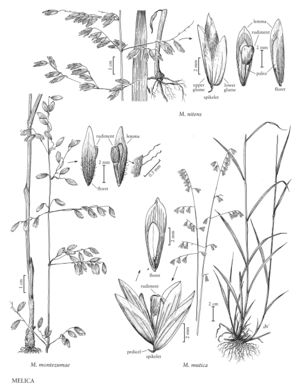Melica montezumae
Plants cespitose, not rhizomatous. Culms 14-100 cm, not forming corms; internodes smooth. Sheaths glabrous or scabrous; ligules 2.5-7 mm; blades 1.2-3 mm wide, abaxial surfaces glabrous, scabridulous, adaxial surfaces puberulent. Panicles 5-25 cm; branches 1-5 cm, appressed to reflexed, straight, with 2-9 spikelets; pedicels sharply bent below the spikelets; disarticulation below the glumes. Spikelets 6-8 mm, with 1 bisexual floret. Lower glumes 5.5-8 mm long, 1.8-3 mm wide, 5-veined; upper glumes 5-8 mm long, 0.7-1.5 mm wide, 3-5-veined; lemmas 4.5-8 mm, 9-15-veined, veins prominent, tuberculate, proximal portion with flat, twisted hairs, distal portion glabrous, chartaceous, apices emarginate to acute, unawned; paleas about 3/4 the length of the lemmas; anthers 1.5-3 mm; rudiments 2-3 mm, obovoid or obconic, clublike, not resembling the bisexual florets. 2n = 18.
Discussion
Melica montezumae grows primarily in shady locations in the mountains of western Texas and adjacent Mexico.
Selected References
None.
